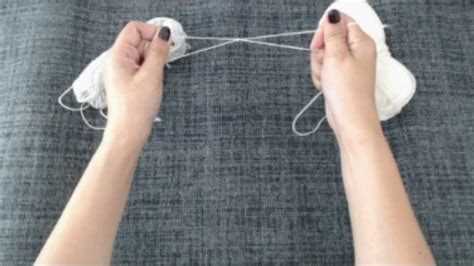Knitting is a popular craft that allows you to create beautiful and functional items, such as scarves, hats, and blankets. However, when using multiple colors or skeins of yarn, you may find yourself needing to add a new yarn to your project. Adding new yarn can be intimidating for beginners, but with a step-by-step guide, you can easily incorporate new colors or skeins without any trouble.
The first step in adding new yarn to your knitting is to prepare the yarn you want to add. Make sure to choose a yarn that is similar in weight and fiber content to the yarn you are currently using. This will help ensure that the transition between colors or skeins is seamless. You can also wind the new yarn into a small ball or skein to make it easier to handle.
Once you have your new yarn ready, you can start the process of adding it to your knitting. One method to join a new yarn is to simply start knitting with it, leaving a tail of around 6 inches. As you continue knitting, the tail will be secured in the stitches, preventing it from unraveling. The tail can then be woven into the finished piece later, ensuring a neat and tidy finish.
Another method to join a new yarn is the spit splice method. This method works best with wool or other animal fiber yarns. To join the new yarn using this method, wet both the ends of the old and new yarn and overlap them. Rub the overlapped ends together vigorously between your hands until they felt together. Once dry, the yarns will be securely joined, and you can continue knitting without any visible join.
Adding new yarn to your knitting can open up endless possibilities for creative designs and color combinations. By following these step-by-step instructions, you’ll be able to seamlessly incorporate new yarn into your project and create stunning knitted pieces.
Gather your supplies
Before you start adding new yarn to your knitting, make sure you have the necessary supplies on hand. Here’s what you’ll need:
- Main yarn: The yarn you have been using for your knitting project. Make sure you have enough of it to finish your project.
- New yarn: The yarn you will be adding to your project. It’s best to choose a yarn that is similar in weight, fiber content, and color to the main yarn.
- Yarn needle: A large-eyed needle used for weaving in the ends of yarn.
- Scissors: To cut the yarn.
- Stitch markers: Optional, but helpful for marking the location where you will be adding the new yarn.
Once you have gathered all your supplies, you are ready to move on to the next step in adding new yarn to your knitting.
Check for yarn compatibility
Before adding a new yarn to your knitting, it’s important to make sure that it is compatible with the existing yarn. This will help ensure that the finished project looks seamless and cohesive.
Here are a few factors to consider when checking for yarn compatibility:
- Fiber type: Different yarns are made from different fibers, such as wool, cotton, acrylic, or blends. It’s best to choose a new yarn that is of a similar fiber type to the existing yarn. Mixing different fiber types can result in uneven tension and texture.
- Gauge: Check the gauge of the new yarn and compare it to the gauge of the existing yarn. The gauge refers to the number of stitches and rows per inch. If the gauges are significantly different, it may be difficult to achieve a consistent fabric.
- Weight: Consider the weight of the new yarn and how it compares to the weight of the existing yarn. Yarns are often classified into different weights, such as lace, fingering, sport, worsted, or bulky. Mixing yarns of different weights can lead to an uneven and unbalanced appearance.
- Color: If you are adding a new yarn with a different color to your knitting, consider how it will blend with the existing color. Sometimes contrasting colors can create interesting effects, but other times they may clash or create a disjointed look.
It’s always a good idea to make a swatch using the new yarn before adding it to your knitting project. This will help you assess how it behaves, how it looks when knitted up, and if it blends well with the existing yarn. If the new yarn doesn’t meet your expectations, you can explore other options or consider using it for a different project.
Secure the old yarn
Before adding new yarn to your knitting, it’s important to secure the old yarn to prevent it from unraveling.
Step 1: Hold both the old yarn and the new yarn together. This will help to create a secure join.
Step 2: Using your knitting needles, knit one stitch with both yarns held together. This will connect the old yarn with the new yarn.
Step 3: After knitting the first stitch, drop the old yarn and continue knitting with the new yarn only.
Step 4: To further secure the join, you can weave in the loose ends of the old yarn and the new yarn. This can be done using a tapestry needle and weaving the ends into the stitches on the wrong side of the work.
By following these steps, you can ensure that the old yarn is securely attached to the new yarn, allowing you to continue your knitting project seamlessly.
Prepare the new yarn
Before adding the new yarn to your knitting, there are a few things you need to do to prepare it:
- Choose the right yarn: Make sure the new yarn you are using is similar in weight, fiber content, and color to the yarn you are already using. This will help ensure that the transition between the two yarns is seamless.
- Wind the new yarn into a ball or cake: If the new yarn is in hanks or skeins, you will need to wind it into a ball or cake before adding it to your knitting. You can do this by using a yarn winder or by winding it by hand.
- Find a suitable joining method: There are several methods you can use to join the new yarn to your knitting, such as the Russian join, spit splice, or simply tying a knot. Choose a method that is secure and will not come undone during wear or washing.
- Prepare the ends of the old and new yarn: If the old yarn is still attached to your knitting, carefully cut it a few inches away from the work. For the new yarn, make sure you have a few inches of tail to work with for joining.
Once you have prepared the new yarn, you are ready to add it to your knitting. Follow the next steps in the guide to seamlessly incorporate the new yarn into your project.
Join the old and new yarn
When you come to the end of your old yarn, you’ll need to join it to the new yarn to continue knitting. Follow these steps to seamlessly transition from one yarn to another.
- Cut the old yarn: Use scissors to cut the old yarn, leaving a tail that is about 6 inches long.
- Prepare the new yarn: Take the end of the new yarn and create a loose slipknot.
- Insert the needle: Insert the needle into the first stitch with both the old and new yarn tails held together.
- Tie a knot: Pass the slipknot of the new yarn through the old yarn tail and tighten it to secure the two yarns together.
- Weave in the ends: Use a tapestry needle to weave the tails of both the old and new yarn into the fabric, hiding them within the stitches.
By joining the old and new yarn in this way, you can ensure that your knitting remains strong and secure. It also creates a smooth transition that is barely noticeable, giving your finished project a polished look.
Weave in the loose ends
Once you have added a new yarn to your knitting project, it’s important to weave in the loose ends to ensure a clean and finished look. Here’s a step-by-step guide on how to do it:
- Thread the loose end onto a tapestry needle: Cut the loose end of the yarn, leaving a tail of about 6 inches. Thread the tail onto a tapestry needle with a large eye.
- Weave under the stitches: Starting from the back side of your work, insert the needle under several stitches, following the same direction as the knitting. This will help secure the end without it being visible from the front.
- Weave in the opposite direction: Once you have woven the yarn under the stitches for a few inches, change direction and bring the needle back through the fabric, weaving in the opposite direction. This will further secure the loose end and prevent it from coming undone.
- Trim off the excess: After weaving in the loose end in two directions, trim any excess yarn close to the fabric, making sure not to cut any stitches.
- Repeat for other loose ends: If you have multiple loose ends from joining new yarns or changing colors, repeat the process for each end.
Note: It is recommended to weave in the loose ends as you go to avoid a large number of loose ends at the end of your project. This will keep your work tidy and eliminate the need for excessive finishing.
Continue knitting with the new yarn
Once you have joined the new yarn, you can continue knitting with it. Follow these steps:
- Hold the two strands of yarn together in your non-dominant hand, with the new yarn behind the old yarn.
- Insert the right needle into the next stitch as if to knit.
- Wrap the new yarn around the tip of the right needle, crossing it over the old yarn.
- Use the right needle to pull the new yarn through the stitch, just like you would with the old yarn.
- Slide the old stitch off the left needle and onto the right needle, completing the stitch with the new yarn.
- Continue knitting across the row or round, using the new yarn to create each stitch.
- Make sure to keep the tension of the new yarn consistent with the tension of the old yarn to maintain an even fabric.
- If your pattern requires a color change, follow the instructions provided to incorporate the new yarn at the designated point.
Remember, practice makes perfect! Don’t be discouraged if your first few stitches with the new yarn feel a little awkward. With time and experience, you’ll become more comfortable with adding new yarn to your knitting.
Finish your project
Once you have added the new yarn to your knitting, it’s time to finish your project. Here are the steps to follow:
- Weave in the ends: Take a darning needle and thread the loose ends of yarn through it. Insert the needle into the stitches of your knitting, following the same direction as the rows. Weave the ends in and out, securing them tightly. Trim any excess yarn.
- Block your project: Blocking is an important step in finishing your knitting. It helps to even out the stitches and give the project its final shape. Depending on the fiber content of your project, you can wet block, steam block, or spray block it. Follow the instructions for blocking based on the type of yarn you used.
- Give it a final check: Once your project is dry, inspect it for any loose stitches or mistakes. Use a crochet hook or knitting needle to fix any issues. Pay attention to the edges and make sure they are neat and even.
- Add any finishing touches: If your project requires any embellishments or details, such as buttons or embroidery, now is the time to add them. Use a tapestry needle or sewing needle to attach any desired elements to your knitting.
- Give it a good blocking: After adding the finishing touches, give your project one final blocking. This will help to set the embellishments and ensure your project looks its best.
Now that your project is finished, you can enjoy the fruits of your labor or gift it to someone special. Remember to take pride in your work and don’t be afraid to show it off!
FAQ:
What is the best way to add new yarn to my knitting?
The best way to add new yarn to your knitting is by using the “knit in” method. This involves knitting a few stitches with both the old and new yarn together to create a secure join.
Can I simply tie a knot to join the new yarn?
Tying a knot to join the new yarn is not recommended as it can create bulkiness and an unsightly knot in your knitting. The “knit in” method or the Russian join method are better options to create a seamless transition.
What should I do if my knitting does not have a natural break to add the new yarn?
If your knitting does not have a natural break to add the new yarn, you can create a false break by slipping a stitch onto a cable needle or scrap yarn, and then continue knitting with the new yarn. Once you reach that stitch again, you can drop the cable needle or scrap yarn and continue knitting with the main yarn.


